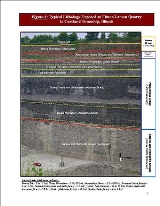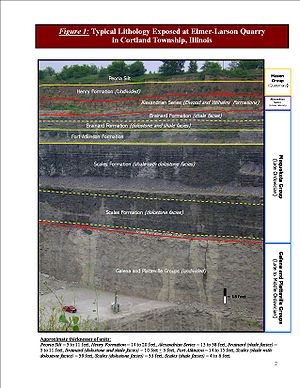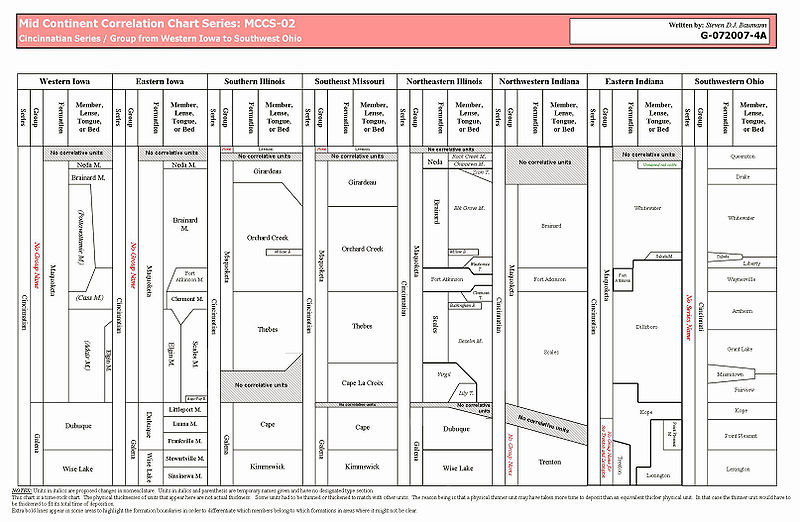
Maquoketa Group
Encyclopedia

Geologic formation
A formation or geological formation is the fundamental unit of lithostratigraphy. A formation consists of a certain number of rock strata that have a comparable lithology, facies or other similar properties...
s. It is Upper Ordovician in age and named for the Maquoketa River
Maquoketa River
The Maquoketa River is a tributary of the Mississippi River, approximately long, in northeastern Iowa in the United States. Its watershed covers within a rural region of rolling hills and farmland southwest of Dubuque. It is not to be confused with the Little Maquoketa River, another distinct...
in Iowa. It exists in Missouri
Missouri
Missouri is a US state located in the Midwestern United States, bordered by Iowa, Illinois, Kentucky, Tennessee, Arkansas, Oklahoma, Kansas and Nebraska. With a 2010 population of 5,988,927, Missouri is the 18th most populous state in the nation and the fifth most populous in the Midwest. It...
, Wisconsin
Wisconsin
Wisconsin is a U.S. state located in the north-central United States and is part of the Midwest. It is bordered by Minnesota to the west, Iowa to the southwest, Illinois to the south, Lake Michigan to the east, Michigan to the northeast, and Lake Superior to the north. Wisconsin's capital is...
, Iowa
Iowa
Iowa is a state located in the Midwestern United States, an area often referred to as the "American Heartland". It derives its name from the Ioway people, one of the many American Indian tribes that occupied the state at the time of European exploration. Iowa was a part of the French colony of New...
, Illinois
Illinois
Illinois is the fifth-most populous state of the United States of America, and is often noted for being a microcosm of the entire country. With Chicago in the northeast, small industrial cities and great agricultural productivity in central and northern Illinois, and natural resources like coal,...
, and Indiana
Indiana
Indiana is a US state, admitted to the United States as the 19th on December 11, 1816. It is located in the Midwestern United States and Great Lakes Region. With 6,483,802 residents, the state is ranked 15th in population and 16th in population density. Indiana is ranked 38th in land area and is...
. It is equivalent to the all but the basal formations of the Cincinnati Group in Ohio. Illinois and Indiana are the only states where the Maquoketa is considered a group. In other states it is a formation. The Maquoketa was deposited in a shallow intercontinental sea. Most of the clastic sediments are derived from the Appalachians, which were being raised at the end of the Ordovician
Ordovician
The Ordovician is a geologic period and system, the second of six of the Paleozoic Era, and covers the time between 488.3±1.7 to 443.7±1.5 million years ago . It follows the Cambrian Period and is followed by the Silurian Period...
. To a lesser degree some of the sediments were derived from the Ozark highlands to the southwest.
Scales Formation
In Illinois the basal formation is called the Scales Formation and consists mainly of dark brown and gray dolomitic shaleShale
Shale is a fine-grained, clastic sedimentary rock composed of mud that is a mix of flakes of clay minerals and tiny fragments of other minerals, especially quartz and calcite. The ratio of clay to other minerals is variable. Shale is characterized by breaks along thin laminae or parallel layering...
. In north central Illinois the bottom half is dominantly a yellowish gray coarse crystalline dolostone (rock form of dolomite
Dolomite
Dolomite is a carbonate mineral composed of calcium magnesium carbonate CaMg2. The term is also used to describe the sedimentary carbonate rock dolostone....
which is related to calcite
Calcite
Calcite is a carbonate mineral and the most stable polymorph of calcium carbonate . The other polymorphs are the minerals aragonite and vaterite. Aragonite will change to calcite at 380-470°C, and vaterite is even less stable.-Properties:...
). It doesn't contain many fossils, although large trilobite
Trilobite
Trilobites are a well-known fossil group of extinct marine arthropods that form the class Trilobita. The first appearance of trilobites in the fossil record defines the base of the Atdabanian stage of the Early Cambrian period , and they flourished throughout the lower Paleozoic era before...
s and large cephalopod
Cephalopod
A cephalopod is any member of the molluscan class Cephalopoda . These exclusively marine animals are characterized by bilateral body symmetry, a prominent head, and a set of arms or tentacles modified from the primitive molluscan foot...
s are known from Elmer-Lason Quarry. It is typically 75 to 100 feet thick. It is the only formation of the Maquoketa Group that is not exposed in northeastern Illinois.
The type section for the Scales Formation is in Jo Daviess County, Illinois
Jo Daviess County, Illinois
Jo Daviess County is a county located in the northwest corner of U.S. state of Illinois. According to the 2010 census, it has a population of 22,678, which is an increase of 1.7% from 22,289 in 2000. Its county seat is Galena....
. In Illinois the Formation is divided into two members, the lower Elgin Member (mostly dark gray to brown and black shale with dolostone) and the upper Clermont Member (upper gray pure shale) both with type sections in Fayette County, Iowa
Fayette County, Iowa
-2010 census:The 2010 census recorded a population of 20,880 in the county, with a population density of . There were 9,558 housing units, of which 8,634 were occupied.-2000 census:...
. However, in Iowa the Scales, Elgin, and Clermont are all members of the Maquoketa Formation (the Maquoketa is not considered a group in Iowa). Over the years this has slowly led to the Scales being used in Eastern Iowa for the dark shale and the Elgin used in Western Iowa to refer to the dolostone
Dolostone
Dolostone or dolomite rock is a sedimentary carbonate rock that contains a high percentage of the mineral dolomite. In old U.S.G.S. publications it was referred to as magnesian limestone. Most dolostone formed as a magnesium replacement of limestone or lime mud prior to lithification. It is...
that grades laterally into the Scales. The difference in terms between Iowa and Illinois has made the present nomenclature all but impractical. There is an active effort to revise the nomenclature. Present studies suggest that the Maquoketa should remain a group and not a formation for practical purposes.

Fort Atkinson Formation
Overlying the Scales Formation is the Fort Atkinson Formation, which has been informally called the Middle or Divine Limestone by drillers. The Fort Atkinson is a dominantly a red, gray, and white coarse crystalline dolostoneDolostone
Dolostone or dolomite rock is a sedimentary carbonate rock that contains a high percentage of the mineral dolomite. In old U.S.G.S. publications it was referred to as magnesian limestone. Most dolostone formed as a magnesium replacement of limestone or lime mud prior to lithification. It is...
with thin beds of green and gray shale. It contains many invertebrate
Invertebrate
An invertebrate is an animal without a backbone. The group includes 97% of all animal species – all animals except those in the chordate subphylum Vertebrata .Invertebrates form a paraphyletic group...
fossils, such as brachiopods and abundant corals. It ranges from 0 to 60 feet in thickness but is typically 40 to 50 feet thick.
Brainard Formation
Above the Fort Atkinson is the Brainard Formation. The Brainard is generally a greenish gray to gray dolomitic soft to hard shale. It contains abundant fossils near the base. It ranges from 0 to 100 feet thick. The variable thickness is due to an erosional unconformity caused by the an ice ageIce age
An ice age or, more precisely, glacial age, is a generic geological period of long-term reduction in the temperature of the Earth's surface and atmosphere, resulting in the presence or expansion of continental ice sheets, polar ice sheets and alpine glaciers...
at the end of the Ordovician, which lowered global sea level.
Neda Formation
The top and youngest formation is the Neda Formation. It exists in small patchy areas and was extensively eroded at the end of the Ordovician. It exists in large isolated patches in the subsurface in LakeLake County, Illinois
Lake County is a county in the northeastern corner of the state of Illinois, on the shore of Lake Michigan. According to the 2010 census, it has a population of 703,462, which is an increase of 9.2% from 644,356 in 2000. Its county seat is Waukegan. The county is part of the Chicago metropolitan area...
, Cook
Cook County, Illinois
Cook County is a county in the U.S. state of Illinois, with its county seat in Chicago. It is the second most populous county in the United States after Los Angeles County. The county has 5,194,675 residents, which is 40.5 percent of all Illinois residents. Cook County's population is larger than...
, Will
Will County, Illinois
As of the census of 2000, there were 502,266 people, 167,542 households, and 131,017 families residing in the county. The population density was 600 people per square mile . There were 175,524 housing units at an average density of 210 per square mile...
and Du Page counties in Illinois. In Illinois it crops out only at Kankakee River State Park
Kankakee River State Park
Kankakee River State Park is an Illinois state park on primarily in Kankakee and Will Counties, Illinois, United States. Originally, of land was donated by Ethel Sturges Dummer for the creation of the state park in 1938. Another was donated by Commonwealth Edison in 1956, and again donated more...
. It is a reddish purple to brown oolitic shale and is sometimes cemented with iron and dolomite. The oolites are black and made of iron oxides instead of the typical calcareous oolites. They are about 0.5 millimeters in diameter. There are no known fossils. In Illinois, it can be as much as 16 feet thick but it is typically no more than 8 feet thick.
Its origin is still debated. We do know that it was deposited near or on an ancient shore and is a sedimentary rock. However, iron oolites are not being actively deposited anywhere in the world today. It is possible that it was originally deposited as a calcareous oolite and hematite
Hematite
Hematite, also spelled as haematite, is the mineral form of iron oxide , one of several iron oxides. Hematite crystallizes in the rhombohedral system, and it has the same crystal structure as ilmenite and corundum...
later replaced the calcite. Or it could have been deposited directly as an iron oolite. There is strong evidence for both theories.
Economic uses

Track ballast
Track ballast forms the trackbed upon which railway sleepers or railroad ties are laid. It is packed between, below, and around the ties. It is used to facilitate drainage of water, to distribute the load from the railroad ties, and also to keep down vegetation that might interfere with the track...
or concrete
Concrete
Concrete is a composite construction material, composed of cement and other cementitious materials such as fly ash and slag cement, aggregate , water and chemical admixtures.The word concrete comes from the Latin word...
aggregate
Construction Aggregate
Construction aggregate, or simply "aggregate", is a broad category of coarse particulate material used in construction, including sand, gravel, crushed stone, slag, recycled concrete and geosynthetic aggregates. Aggregates are the most mined material in the world...
and is often stripped and piled as waste in open-pit quarries
Quarry
A quarry is a type of open-pit mine from which rock or minerals are extracted. Quarries are generally used for extracting building materials, such as dimension stone, construction aggregate, riprap, sand, and gravel. They are often collocated with concrete and asphalt plants due to the requirement...
. The main exception is at the Neda's type section
Type locality (geology)
Type locality , also called type area or type locale, is the where a particular rock type, stratigraphic unit, fossil or mineral species is first identified....
in Wisconsin, where it was once mined for iron ore. In Illinois the Neda is too thin and patchy to be economic. The Brainard is too soft to be used as anything other than fill soil. The Fort Atkinson is used to a limited degree as a decorative stone
Flagstone
Flagstone, is a generic flat stone, usually used for paving slabs or walkways, patios, fences and roofing. It may be used for memorials, headstones, facades and other constructions. The name derives from Middle English flagge meaning turf, perhaps from Old Norse flaga meaning slab.Flagstone is a...
. The Scales is buried too deep and contains too much dolostone to be used for oil shale
Oil shale
Oil shale, an organic-rich fine-grained sedimentary rock, contains significant amounts of kerogen from which liquid hydrocarbons called shale oil can be produced...
.
The Maquoketa group is also a major aquitard. This means that it is very impermeable, and therefore water only measurably flows through it on geologic time-scales. For this reason it cannot serve as a source of groundwater.
Although not useful to industry it does contain rare and diverse fossil
Fossil
Fossils are the preserved remains or traces of animals , plants, and other organisms from the remote past...
s, some of which are only known in Illinois such as Tentaculites oswegoensis
Tentaculites oswegoensis
Tentaculites oswegoensis is a small animal of unknown origin that is often classified with molluscs or even as marine worms with a hard body. The genus Tentaculites was named in 1820 by von Schlotheim. This particular species was named in the late 1960s and is known from the Upper Ordovician...
, a small unclassified fossil named after Oswego, Illinois
Oswego, Illinois
Oswego is a village in Kendall County, Illinois, United States. As of the 2010 census, the village population was 30,355. Its population has more than doubled since the 2000 census count of 13,326...
and found in the basal Brainard.

